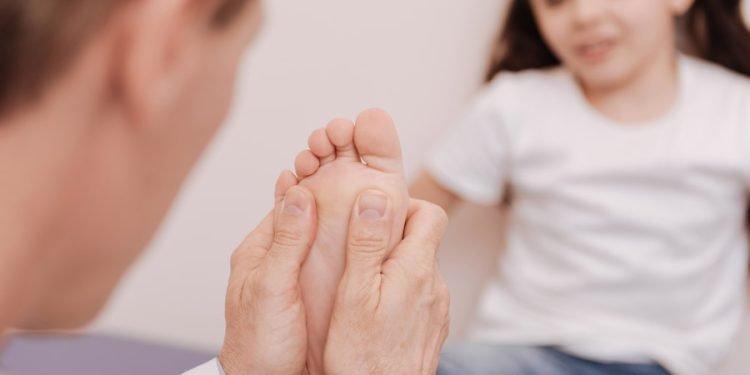Parents have a shared duty to keep their children safe and assist them in growing healthy in all aspects. Besides providing nutritious food, toys and helping children when they call, you can easily forget a child’s tiny feet, yet they play a fundamental role in their growth.
If you notice any abnormalities on your child’s foot, like a plantar wart, painful heels, or flat feet, you need to visit pediatric foot care and help your child grow with safe feet. You can learn more about solving pediatric foot problems: what parents need to know to take good care of their child.
Non-Verbal Signs and Symptoms a Parent Should Look Out For
Most child activities include running around and jumping non-stop when they aren’t watching the television. When a child isn’t doing any of these activities, you’ll guess they’re unwell because they may not communicate their feelings.
Here’s a list of non-verbal cues you can observe from your child to tell if something is wrong.
- Loss of interest in activities a child loves and enjoys
- A child can’t keep up with peers, especially when running
- Complaints of pain in the lower extremities
- Tripping and often falling, especially when running.
- A child avoids showing their feet or keeping them elevated.
Monitor your child’s walking patterns and watch how their feet point; inwards or outwards. Observe if they’re walking on their toes, especially 2–3 months after learning to walk. If you notice one or two of the above signs, find help from a pediatrician immediately.
Common Pediatric Foot Problems
The foot conditions that affect children are also familiar to adults, like plantar warts, painful heels, flat feet, and ingrown toenails. These conditions may vary in children because they’re still developing, and their lifestyles are highly active. For adults, particularly those in physically demanding professions like construction or manufacturing, selecting the right safety boots is essential. Safety boots not only protect the feet but can also provide additional support and cushioning to help alleviate the discomfort associated with foot conditions. This makes them a crucial choice for adults looking to ensure both safety and comfort while on their feet for extended periods during work.
Ingrown Toenail
An ingrown toenail happens when the edge of the nail on the big toe grows into the adjacent skin. As a result, the toe is painful, and if undetected, it can lead to an infection. Although ingrown toenails can affect anyone, they’re frequent in children and more prevalent in teenagers. It may be happening due to wearing tight-fitting shoes.
Plantar Warts
Plantar warts affect the sole. It manifests as a skin lesion and is caused by a virus. They appear like corns or calluses and can easily be mistaken. Warts appear like tiny black dots within a lesion and can appear anywhere on the skin around the toenails. Still, they’re most common on the sole because it’s more susceptible to microtrauma creating an entry point for the wart virus. They’re more common in children and young adults because adults have better immunity.
Flat Feet
Flat feet (pes planus) are feet with minimal or no arches, and they can occur due to orthopedic developmental changes that a child can outgrow over time. However, treatment might be necessary if there’s pain, difficulty walking, and one foot is flatter than the other. If your child’s foot suffers from severe congenital foot defects, it may lead to severe flattening, which requires treatment. To learn about the latest advancements in modern orthopedics, click here to explore cutting-edge treatments and technologies designed to improve patient outcomes.
Heel Pain
Painful heels can result from plantar fasciitis, an inflamed section of the heel bone where the plantar fascia is a thick tissue. The pain is on the bottom of the heel, common with adolescents, and the cause may be a condition known as Sever’s disease. The condition is common with active children between 8 and 14 years. Parents looking for a natural and supportive option might consider barefoot shoes for kids, which can be found at Hike Footwear’s collection.
Structural Issues Parents shouldn’t Worry About
Anything you observe on your child that looks abnormal can worry you, but some structural issues aren’t a threat. They include;
In toeing/out-toeing
In these conditions, the toe can face either way, which can happen due to abnormal twisting of the upper or lower parts of the leg. However, some in-toeing cases are related to curvature on the affected foot. Although in-toeing, in most cases, resolves on its own, there’s no need to worry. The out-toeing can be more concerning, and you can seek treatment.
Flat Feet
Pediatric flat foot is a regular occurrence during a child’s early development. If your child hits three without developing arches, wait until eight years to seek help. Your child might have a pediatric flexible flatfoot. No treatment is required unless the foot is painful or causes foot biomechanics, which can also be corrected with orthotics.
Sever’s disease
Sever’s disease is the leading cause of heel pain in adults and adolescents. Besides the title, Sever’s isn’t a disease, but a growing pain caused by variance in bone growth rate in the heel and Achilles tendon. The condition usually resolves on its own, but if it causes too much pain that hinders normal activities, treatment is administered to ease the pain and allow the child to carry on with everyday activities.












